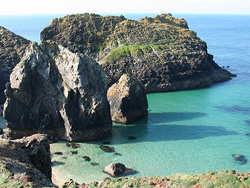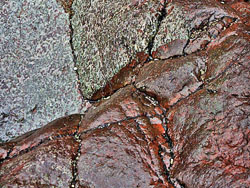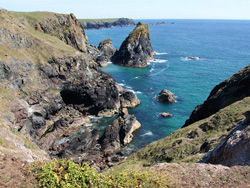Getting ancient oceans to the surface: ophiolites and obduction
 The Earth consists of a central core, a middle mantle, and an outer crust. This crust is broken into different plates, and the movement of these plates is known as ‘Plate Tectonics’. In some places, plates are moving apart (e.g. the Mid Atlantic Ridge) and in other places, plates are colliding together (e.g. Indonesia).
The Earth consists of a central core, a middle mantle, and an outer crust. This crust is broken into different plates, and the movement of these plates is known as ‘Plate Tectonics’. In some places, plates are moving apart (e.g. the Mid Atlantic Ridge) and in other places, plates are colliding together (e.g. Indonesia).
Where plates move apart beneath an ocean, new oceanic crust is formed to fill the gap. This crust is layered; the upper layer consists of ocean sediments and lava erupted onto the ocean floor, while the lower levels are made of intrusions of magma that solidify to form gabbro. Serpentinite (also known as peridotite) records the part of the Earth’s mantle just beneath the crust. This sequence of oceanic crust and mantle rocks, known as an ophiolite, is what is seen at the Lizard.
The Lizard Complex rocks were originally kilometres beneath the Earth’s surface, under an ocean, but were pushed up to the Earth’s surface as two continental plates collided (a process known as obduction) over 300 million years ago.
Walking across the Moho
 At Coverack, 11 miles from Kynance, the transition from grey gabbro to red serpentinite is clearly exposed along the beach at low tide.
At Coverack, 11 miles from Kynance, the transition from grey gabbro to red serpentinite is clearly exposed along the beach at low tide.
This boundary between the Earth’s crust and the Earth’s mantle is known as the Mohorovicic Discontinuity (the “Moho”), and typically lies at ~7 km beneath the sea floor. Coverack is one of the few places in the world where it is seen at the Earth’s surface.
Exploring Kynance
Kynance Cove is famous for its excellent exposures of striking serpentinite, and particularly good examples of both red and green serpentinite are seen within a natural tunnel on the beach, just past the café.
 The geomorphology of the cove is strikingly beautiful, and at low tide the waves crash onto both sides of a spit of sand that joins the main headland to a series of sea stacks. This landscape is a result of the geology; various rocks of the Lizard Complex have been eroded at different rates.
The geomorphology of the cove is strikingly beautiful, and at low tide the waves crash onto both sides of a spit of sand that joins the main headland to a series of sea stacks. This landscape is a result of the geology; various rocks of the Lizard Complex have been eroded at different rates.
The short walk from the Lizard Point lighthouse along the cliffs to Kynance is a must during a visit to Cornwall. The walk is along a good path and easily accessible. It is possible to glimpse good exposures of serpentinite at stiles along the way (where many feet have polished the rocks!)
Kynance Cove is known for its flora and fauna as well as its geological significance, and it is sometimes possible to spot the rare Cornish chough, the bird of the Cornish coast of arms, perching in the clifftops.
Text courtesy of Natasha Smith (GSL Geoconservation Committee)
Nominated by: Marnix Roels (Facebook), @WBSGeogratweets (twitter)